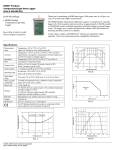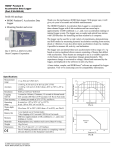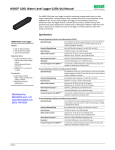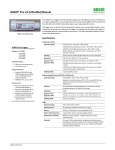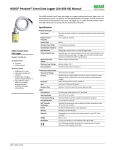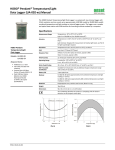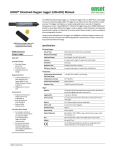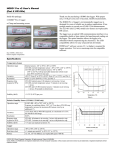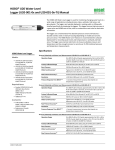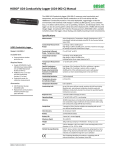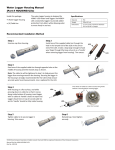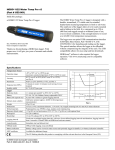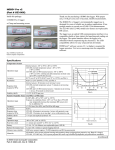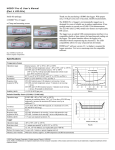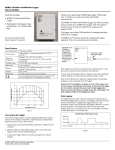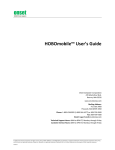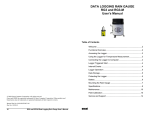Download HOBO U20 Water Level Logger User Manual
Transcript
HOBO® U20 Water Level Logger (Part # U20-001-01) Inside this package: • HOBO U20 Water Level Logger • Calibration certificate Doc #8976-G, MAN-U20-001-01 Onset Computer Corporation Thank you for purchasing a HOBO data logger. With proper care, it will give you years of accurate and reliable measurements. The HOBO Water Level Logger is designed to measure water level in wells, rivers, streams, and lakes. The logger uses a maintenance-free absolute pressure sensor and features a durable stainless steel housing and ceramic pressure sensor. The logger uses precision electronics to measure pressure and temperature. Using a reference water level, the HOBOware® software automatically converts the pressure readings into water level readings. Furthermore, the software supports compensation for temperature, fluid density, and barometric pressure. The logger has enough memory to record over 21,700 combined pressure and temperature measurements. The logger uses an optical USB communications interface (USB-Optic Base Station, Part # BASE-U-4, with COUPLER2-B) for launching and reading out the logger. The optical interface allows the logger to be offloaded without breaking the integrity of the seals. The USB compatibility allows for easy setup and fast downloads. HOBOware software is also required for logger operation. Visit www.onsetcomp.com for compatible software. Specifications Pressure Sensor 0 to 207 kPa (0 to 30 psia); approximately 0 to 9 m (0 to 30 ft) of water depth at sea level, or 0 to 12 m (0 to 40 ft) of water at 3,000 m (10,000 ft) of altitude Factory calibrated range 69 to 207 kPa (10 to 30 psia), 0° to 40°C (32° to 104°F) Burst pressure 310 kPa (45 psia) or 18 m (60 ft) depth Typical error - 0.05% FS, 0.5 cm (0.015 ft) water Water level accuracy* Maximum error - 0.1% FS, 1.0 cm (0.03 ft) water Raw pressure accuracy** 0.3% FS, 0.62 kPa (0.09 psi) maximum error Resolution < 0.02 kPa (0.003 psi), 0.21 cm (0.007 ft) water Pressure response time 90% < 1 second Thermal response time (90%)† Approximately 10 minutes in water to achieve full temperature compensation of the pressure sensor * With accurate reference water level measurement and Barometric Compensation Assistant data ** Absolute pressure sensor accuracy includes all pressure drift, temperature, and hysteresis-induced errors † Maximum error due to rapid thermal changes is approximately 0.5% Temperature Sensor Operation range -20° to 50°C (-4° to 122°F) 2 Accuracy 0.37°C at 20°C (0.67°F at 68°F), see Plot A Accuracy Resolution Resolution 0.1°C at 20°C (0.18°F at 68°F) (10-bit), see Plot A 1.5 Response time (90%) 3.5 minutes in water (typical) Stability (drift) 0.1°C (0.18°F) per year Logger 1 Real-time clock ± 1 minute per month 0° to 50°C (32° to 122°F) Battery 2/3 AA, 3.6 Volt Lithium, factory-replaceable Battery life (typical use) 5 years with 1 minute or greater logging interval 0.5 Memory (non-volatile) 64K bytes memory (approx. 21,700 pressure and temperature samples) 2.46 cm (0.97 inches) diameter, 15 cm (5.9 inches) length; Dimensions 0 mounting hole 6.3 mm (0.25 inches) diameter -20 0 20 40 Weight Approximately 210 g (7.4 oz) Temperature (°C) Accuracy/Resolution (°C) Operation range Wetted materials Shock/drop Logging interval Launch modes Offload modes Battery indication 316 stainless steel, Viton® o-rings, acetyl cap, ceramic sensor Plot A Logger is sensitive to shocks. Handle with care and avoid any impact. Always use proper packaging when shipping the logger. Fixed-rate or multiple logging intervals, with up to 8 user-defined logging intervals and durations; logging intervals from 1 second to 18 hours. Refer to HOBOware software manual. Immediate start and delayed start Offload while logging; stop and offload Battery voltage can be viewed in status screen and optionally logged in datafile. Low battery indication in datafile. The CE Marking identifies this product as complying with the relevant directives in the European Union (EU). Accessories available • 50-ft 1/16" Teflon®-Coated Stainless Steel Cable (Part # CABLE-1-50) • 300-ft 1/16" Teflon-Coated Stainless Steel Cable (Part # CABLE-1-300) • Crimp sleeve for Teflon-Coated Stainless Steel Cable (Part # CABLE-1-CRIMP) © 2005, 2006 Onset Computer Corporation Part #: MAN-U20-001-01, Doc #: 8976-G HOBO U20 Water Level Logger Connecting the logger The HOBO Water Level Logger requires a coupler (Part # COUPLER2-B) and USB Optic Base Station (Part # BASE-U-4) or HOBO Waterproof Shuttle (Part # U-DTW-1) to connect to the computer. 1. Install the logger software on your computer before proceeding. 2. Follow the instructions that came with your base station or shuttle to attach the base station or shuttle to a USB port on the computer. 3. Unscrew the black plastic end cap from the logger by turning it counter-clockwise. 4. Attach the coupler to the base station or shuttle, then insert the logger into the coupler with the flat on the logger aligned with the arrow on the coupler label. Gently twist the logger to be sure that it is properly seated in the coupler (it should not turn). are no user serviceable parts inside the case. Contact Onset technical support if your logger requires servicing. • This logger can be damaged by shock. Always handle the logger with care. The logger may lose its calibrated accuracy or be damaged if it is dropped. Use proper packaging when transporting or shipping the logger. • 316 stainless steel has good corrosion resistance, but it can be damaged by contact with dissimilar metals or through crevice corrosion. The logger should not be deployed in salt or brackish water, or the housing will eventually fail and water will destroy the electronics. If long-term deployment in salt water is required, place the logger in a sealed bladder containing a non-corrosive liquid. The pressure outside the bladder will be transmitted to the pressure sensor inside the logger. Always rinse the logger with fresh water after deployment in salt or brackish water. • Check a materials-compatibility chart before deploying the logger in locations where untested solvents are present: − The logger is shipped with Viton O-rings installed. Viton has an excellent resistance to most solvents and is suitable for deployments in water that contain a mixture of most fuels, solvents and lubricants. However, the Viton O-rings are sensitive to polar solvents (acetone, ketone), ammonia, and brake fluids. − The black acetyl cap is provided to help protect the communications window. Acetyl is resistant to most solvents, fuels, and lubricants. − The polycarbonate communications window is sealed as an additional barrier to water and dirt entering the logger housing. Operation 5. If you are using the HOBO Waterproof Shuttle, briefly press the coupler lever to put the shuttle into base station mode. 6. If the logger has never been connected to the computer before, it may take a few seconds for the new hardware to be detected by the computer. A light (LED) in the communications window of the logger confirms logger operation. The following table explains when the logger blinks during logger operation: When: The logger is logging 7. Use the logger software to launch the logger. 8. You can check the logger’s status, read out the logger while it continues to log, stop it manually with the software, or let it record data until the memory is full. Refer to the software user’s guide for complete details on launching, reading out, and viewing data from the logger, including multiple logging intervals and barometric compensation. Important: USB communications may not function properly at temperatures below 0°C (32°F) or above 50°C (122°F). Note: The logger consumes significantly more power when it is “awake” and connected to a base station or shuttle. To conserve power, the logger will go into a low-power (sleep) mode if there has been no communication with your computer for 30 minutes. To wake up the logger, remove the logger from the coupler, wait a moment, then re-insert the logger. Note: The first time you launch the logger, the deployment number will be greater than zero. Onset launches the loggers to test them prior to shipping. Protecting the logger • Important! Do not attempt to open the logger housing! Unscrewing the stainless steel nose cone of the logger will cause serious damage to the pressure sensor and logger electronics. There 2 The logger is awaiting a start because it was launched in Start At Interval or Delayed Start mode The light: Blinks once every one to four seconds (the shorter the logging interval, the faster the light blinks); blinks when logging a sample Blinks once every eight seconds until logging begins Sample and event logging The logger can record two types of data: samples and events. Samples are the sensor measurements recorded at each logging interval (for example, the pressure every minute). Events are independent occurrences triggered by a logger activity, such as Bad Battery or Host Connected. Events help you determine what was happening while the logger was logging. The logger stores 64K of data, and can record over 21,700 samples of pressure and temperature. Barometric Compensation The HOBO Water Level Logger records absolute pressure, which is later converted to water level readings by the software. In this application, absolute pressure includes atmospheric pressure and water head. Atmospheric pressure is nominally 100 kPa (14.5 psi) at sea level, but changes with weather and altitude. Left uncompensated, barometric variations could result in errors of 0.6 m (2 ft) or more. To compensate for barometric pressure changes, HOBO U20 Water Level Logger you can use another HOBO Water Level Logger as a barometric reference. The 0-9m (0-30 ft) HOBO Water Level Logger (U20-001-01) is a good barometric reference due to its smaller range, temperature-compensated accuracy, and rugged stainless steel case. The barometric reference is typically deployed in the same well or at the same location as the water level of interest, but rather than being placed in the water column, it is deployed above the water in air. Fortunately, barometric pressure readings are consistent across a region (except during fast-moving weather events), so you can generally use barometric pressure readings that are taken within 15 km (10 miles) of the logger or more, without significantly degrading the accuracy of the compensation. • Use a no-stretch wire to hang the water level logger. Any change in length of the wire will result in a 1-to-1 corresponding error in the depth measurement. Onset supplies a 1/16" Teflon®-coated stainless steel cable and cable crimp sleeves for this purpose. Regardless of the source, always pull-test a cable prior to deploying a logger in a well to be sure that it is up to the job. • If possible, when deploying the logger in rivers, streams and ponds, use a stilling well. A simple stilling well can be constructed with PVC or ABS pipe. A properly constructed stilling well helps to protect the logger from currents, wave action, and debris. Deploying the Logger • Periodically inspect the logger for fouling. Biological growth on the face of the pressure sensor will throw off the pressure sensor’s accuracy. • The HOBO Water Level Logger is designed to be easy to deploy in many environments. The logger uses an absolute pressure sensor, so no vent tube is required. The small size of the logger is convenient for use in small wells and allows the logger to be mounted and/or hidden in the field. • Be very careful not to exceed the burst pressure for the logger. The pressure sensor will burst if the maximum depth is exceeded (see specifications table). The logger should be positioned at a depth where the logger will remain in the water for the duration of the deployment, but not exceed the rated bursting depth. Logger Calibration The pressure sensor in each HOBO Water Logger is individually calibrated. During calibration, raw pressure sensor data is collected at multiple pressures and temperatures over the calibrated range of the logger (see the specifications table). This data is used to generate calibration coefficients that are stored in the logger’s non-volatile memory. The calibration coefficients are then checked to be sure that the logger meets its stated accuracy over the calibrated range. The pressure sensor can be used at pressures and temperatures that are outside of the calibrated range, but the accuracy can not be guaranteed. Important: Never exceed the burst pressure of the sensor! Recalibration All pressure sensors drift over time. The drift for the pressure sensor and electronics in the HOBO Water Level logger is less than 0.3% FS (worst case) per year. In most applications, drift is not a significant source of error, because the offset created by any drift is zeroed out when you take a manual reference level measurement and use the logger software to automatically calculate the level readings relative to the reference measurement. In effect, you are re-zeroing the sensor each time you apply a reference reading to the data file. • The pressure sensor is temperature compensated over the range of 0° to 40°C (32° to 104°F). To obtain the highest level of accuracy, the logger should be allowed to come to full temperature equilibrium (approximately 30 minutes) before any reference levels are recorded. In addition, sudden temperature changes should be avoided. When deploying a HOBO Level Logger as a barometer, some consideration should be made to minimize the rate of temperature fluctuations. Ideally, the logger should be hung several feet below ground level in an observation well so that ground temperatures are stable. If that is not possible (or if a well is not used), try to put the logger in a location where it will not be subject to rapid daily temperature cycles. • When deploying a HOBO Water Level logger in a well, make sure the well is vented to the atmosphere. Typically, a small hole can be drilled in the well cap to ensure that the pressure inside and outside the well is at equilibrium. If this is not possible, the barometric reference should be used inside the same well. Pressure sensor drift matters only when absolute pressure values are needed, or if there are no recent reference level or depth measurements available. For example, if the logger is deployed for one year and no new reference level readings are taken during the deployment, it is possible that the sensor could have drifted as much as 0.3% FS by the end of the deployment. It is possible to determine the actual amount of drift during a deployment if a reference level is taken at the beginning and the end of a long-term deployment. The results of applying the two different reference levels (once at the beginning of the datafile, and again at the end of the data file) can be compared. Any difference between the files indicates the amount of sensor drift (assuming accurate reference levels). You can check the differential accuracy of your loggers for water level measurements by deploying the loggers at two depths and comparing the difference in level readings. When verifying the accuracy this way, be sure to allow the loggers’ temperature to stabilize at each depth. Use the logger software to convert the readings from pressure to level. The level readings should be taken close enough together that the barometric pressure does not change. 3 HOBO U20 Water Level Logger You can check the absolute pressure accuracy of your HOBO Water Level Logger by comparing its ambient pressure readings to a second HOBO logger. Their readings should be within each other’s specified accuracy. Alternatively, you can check the pressure reading against an accurate local barometer. If you use a non-local source of barometric information, such as the NOAA website, adjust for altitude. If you would like to have your logger’s absolute accuracy verified against a NIST standard, or to have your logger recalibrated, contact Onset or your place of purchase for pricing and return arrangements. Battery The battery in the HOBO Water Level Logger is a 3.6 Volt lithium battery. The battery life of the logger should be about five years or more. Actual battery life is a function of the number of deployments, logging interval, and operation/storage temperature of the logger. To obtain a five-year battery life, a logging interval of one minute or greater should be used and the logger should be operated and stored at temperatures between 0° and 25°C (32° and 77°F). Frequent deployments with logging intervals of less than one minute, and continuous storage/operation at temperatures above 35°C will result in Service and Support As part of Onset’s ongoing efforts to provide 100% customer satisfaction, our Continuing Engineering Group constantly monitors and evaluates all of our products and software. In the unlikely event any significant defect is found, Onset will notify you. If you find a defect, please e-mail us at [email protected]. HOBO products are easy to use and reliable. In the unlikely event that you have a problem with this instrument, contact the company where you bought the logger: Onset or an Onset Authorized Dealer. Before calling, you can evaluate and often solve the problem if you write down the events that led to the problem (are you doing anything differently?) and if you visit the Technical Support section of the Onset web site at www.onsetcomp.com/support.html. When contacting Onset, ask for technical support and be prepared to provide the product number and serial number for the logger and software version in question. Also completely describe the problem or question. The more information you provide, the faster and more accurately we will be able to respond. Onset Computer Corporation 470 MacArthur Blvd., Bourne, MA 02532 Mailing: PO Box 3450, Pocasset, MA 02559-3450 Phone: 1-800-LOGGERS (1-800-564-4377) or 508-759-9500 Fax: 508-759-9100 E-mail: [email protected] Internet: www.onsetcomp.com Warranty Onset Computer Corporation (Onset) warrants to the original end-user purchaser for a period of one year from the date of original purchase that the HOBO® product(s) purchased will be free from defect in material and workmanship. During the warranty period Onset will, at its option, either repair or replace products that prove to be defective in material or workmanship. This warranty shall terminate and be of no further effect at the time the product is (1) damaged by extraneous cause such as fire, water, lightning, etc. or not maintained in accordance with the accompanying documentation; (2) modified; (3) improperly installed; (4) repaired by someone other than Onset; or (5) used in a manner or purpose for which the product was not intended. THERE ARE NO WARRANTIES BEYOND THE EXPRESSED WARRANTY ABOVE. IN NO EVENT SHALL ONSET BE LIABLE FOR LOSS OF PROFITS OR INDIRECT, CONSEQUENTIAL, INCIDENTAL, SPECIAL OR OTHER SIMILAR DAMAGES ARISING OUT OF ANY BREACH OF THIS CONTRACT OR OBLIGATIONS UNDER THIS CONTRACT, INCLUDING BREACH OF WARRANTY, NEGLIGENCE, STRICT LIABILITY, OR ANY OTHER LEGAL THEORY. Limitation of Liability. The Purchaser's sole remedy and the limit of Onset's liability for any loss whatsoever shall not exceed the Purchaser's price of the product(s). The determination of suitability of products to the specific needs of the Purchaser is solely the Purchaser's responsibility. THERE ARE NO WARRANTIES BEYOND THE EXPRESSED WARRANTY OFFERED WITH THIS PRODUCT. EXCEPT AS SPECIFICALLY PROVIDED IN THIS DOCUMENT, THERE ARE NO OTHER WARRANTIES EXPRESS OR IMPLIED, INCLUDING BUT NOT LIMITED TO, ANY IMPLIED WARRANTIES OF MERCHANTIBILITY OR 4 significantly lower battery life. For example, continuous logging at a one-second logging interval will result in a battery life of approximately one month. The logger can report and log its own battery voltage. If the battery falls below 3.1 V, the logger will record a “bad battery” event in the datafile. If the datafile contains “bad battery” events, or if logged battery voltage repeatedly falls below 3.3 V, the battery is failing and the logger should be returned to Onset for battery replacement. To have your logger’s battery replaced, contact Onset or your place of purchase for return arrangements. Do not attempt to replace the battery yourself. Severe damage to the logger will result if the case is opened without special tools, and the warranty will be voided. WARNING: Do not cut open, incinerate, heat above 100°C (212°F), or recharge the lithium battery. The battery may explode if the logger is exposed to extreme heat or conditions that could damage or destroy the battery case. Do not dispose of the logger or battery in fire. Do not expose the contents of the battery to water. Dispose of the battery according to local regulations for lithium batteries. FITNESS FOR A PARTICULAR PURPOSE. NO INFORMATION OR ADVICE GIVEN BY ONSET, ITS AGENTS OR EMPLOYEES SHALL CREATE A WARRANTY OR IN ANY WAY INCREASE THE SCOPE OF THE EXPRESSED WARRANTY OFFERED WITH THIS PRODUCT. Indemnification. Products supplied by Onset are not designed, intended, or authorized for use as components intended for surgical implant or ingestion into the body or other applications involving life-support, or for any application in which the failure of the Onset-supplied product could create or contribute to a situation where personal injury or death may occur. Products supplied by Onset are not designed, intended, or authorized for use in or with any nuclear installation or activity. Products supplied by Onset are not designed, intended, or authorized for use in any aeronautical or related application. Should any Onset-supplied product or equipment be used in any application involving surgical implant or ingestion, life-support, or where failure of the product could lead to personal injury or death, or should any Onset-supplied product or equipment be used in or with any nuclear installation or activity, or in or with any aeronautical or related application or activity, Purchaser will indemnify Onset and hold Onset harmless from any liability or damage whatsoever arising out of the use of the product and/or equipment in such manner. Returns Please direct all warranty claims and repair requests to place of purchase. Before returning a failed unit directly to Onset, you must obtain a Return Merchandise Authorization (RMA) number from Onset. You must provide proof that you purchased the Onset product(s) directly from Onset (purchase order number or Onset invoice number). Onset will issue an RMA number that is valid for 30 days. You must ship the product(s), properly packaged against further damage, to Onset (at your expense) with the RMA number marked clearly on the outside of the package. Onset is not responsible for any package that is returned without a valid RMA number or for the loss of the package by any shipping company. Loggers must be clean before they are sent back to Onset or they may be returned to you. Repair Policy Products that are returned after the warranty period or are damaged by the customer as specified in the warranty provisions can be returned to Onset with a valid RMA number for evaluation. ASAP Repair Policy. For an additional charge, Onset will expedite the repair of a returned product. Data-back™ Service. HOBO data loggers store data in nonvolatile EEPROM memory. Onset will, if possible, recover your data. Tune Up Service. Onset will examine and retest any HOBO data logger. © 2005, 2006 Onset Computer Corporation. All rights reserved. Part #: MAN-U20-001-01, Doc #: 8976-G, Patent #: 6,826,664 Onset, HOBO, and HOBOware are registered trademarks of Onset Computer Corporation. Teflon and Viton are registered trademarks of DuPont. Other products and brand names may be trademarks or registered trademarks of their respective owners.




